on Kia EV9, Martian tire, importance of innovation, customer satisfaction, & the lithium challenge
Kia EV9. . .conceptual tire for Mars. . .the tech experience. . .customer satisfaction. . .women drivers are better. . .lithium demand. . .Range Rover Sport review. . .safety for EVs. . .Euro powertrain sales. . .
About the 2024 Kia EV9
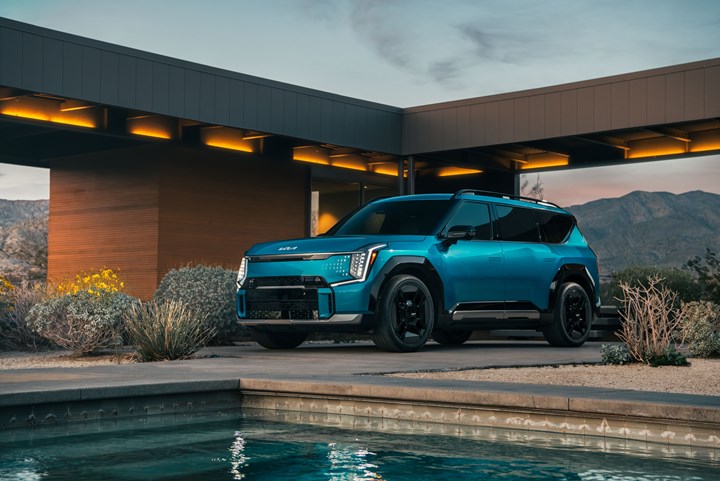
The Kia EV9: Stylish, three rows and an electric propulsion system. (Image: Kia)
There are plenty of three-row midsize SUVs out there.
Like the Grand Cherokee L and the Chevrolet Traverse and the Ford Explorer and the Dodge Durango and. . . .
But what’s not out there is a three-row midsize electric SUV from one of the usual brands.*
For the moment.
Because Kia will soon be launching the EV9 (going on sale Q4).
One thing to consider regarding this vehicle:
In model year 2020 Kia launched the Telluride, a three-row SUV specifically designed for the U.S. market.
The Telluride was named the 2020 North American Utility Vehicle of the Year by NACTOY, besting the other two finalists in the Utility category, the Hyundai Palisade and Lincoln Aviator.
While the EV9 is meant to be a global vehicle and not one that was specifically U.S. focused, it is absolutely evident that there are a lot of learnings from the Telluride encompassed by the new electric vehicle.
(This raises a question: Given that pickups are the bread of the Detroit Three midsize and larger SUVs are the butter, where are the electric three-rows?)
::
Initially the EV9, which is based on the E-GMP platform that underpins the two-row Kia EV6 crossover, will be imported to the U.S.
But Kia will start building it in its plant in West Point, Georgia, in Q2 2024. It is investing more than $200-million in the factory to do so.
Asked whether the production of the EV9 in the plant is predicated on the possibility of purchasers getting a tax credit under the IRA, Russell Wagner, vice president of Marketing for Kia America, replies that that is certainly beneficial, but makes another point:
“Kia builds products where it sells them.”
The Telluride, Sorento and Sportage SUVs and the K5 midsize sedan are presently being built in West Point.
Additionally, the Hyundai Motor Group, of which Kia is an element, is building “Hyundai Motor Group Metaplant America” (HMGMA) in Bryan County, Georgia.
HMGMA will be an EV-dedicated factory, building vehicles for Kia Hyundai and Genesis. It is to be opened in 2025.
::
As mentioned, the EV9 and the EV6 share the same E-GMP platform.
It is notable how flexible it is.
- Wheelbase: EV9, 122 inches EV6, 114.2 inches
- Length: EV9, 197.2/197.4 inches EV6, 184.3/184.8 inches
- Width: EV9, 77.9 inches EV6, 74/74.4 inches
- Height: EV9, 70.1 inches EV6, 60.8 inches
::
The EV9 is unashamedly big and boxy. Because that’s what vehicles that carry people and cargo ought to be. (Although they’ve given up nothing on style.)
For people it offers:
- First row: 41.2 inches of headroom, 41.4 inches of legroom
- Second row: 39.8 inches of headroom, 42.8 inches of legroom
- Third row: 39.5 inches of headroom, 32 inches of legroom
And for stuff:
- All rows up: 20.2 cubic feet
- Third folded: 43.5 cubic feet
- 2nd & 3rd folded: 81.7 cubic feet
Oh. There’s a 3.2-cubic foot frunk, too.
::
Of course, the EV aspect.
First know that all models have an 800-Volt electrical architecture. That means quick charging capability on a DC fast charger: charging speed up to 236 kW. Or it can go from 10 to 80% charge in <25 minutes.
There are four flavors of the SUV: Light, Wind, Land, and GT-Line
Light is the base model and there are two variants, both of which are rear-wheel drive: One with a 76.1-kWh battery that provides an estimated 225 miles of range; the motor is rated at 215 hp and 258 lb-ft of torque.
Then there is a Light variant with an extended-range, 99.8-kWh battery. It provides 300 miles of range. In this setup the motor is 210 hp with 258 lb-ft of torque.
Wind and Land are both dual-motor, all-wheel drive models. Both have the 99.8-kW battery; it provides the former with a 285-mile range and the latter 275. Both produce 379 hp and up to 516 lb-ft of torque.
The GT-Line is AWD and has the same setup as the Wind and Land, but its range, given that this is the performance model, is 270 miles.
::
Like other OEMs, Kia has its eye on revenue-enhancing OTAs—over-the-air updates.
Among those on tap are premium data services, the ability to make the vehicle go faster (0 to 60 mph <5 seconds), remote parking assist (push button positioning into and out of parking spaces). . .and something that is exceedingly clever and undoubtedly something that certain other OEMs are going to quickly emulate:
The EV9 is available with what’s called the “Digital Pattern Lighting Grille.” When the vehicle is off, it is a plane surface. When the SUV is turned on, the previously concealed lights illuminate and animate.
Owners will be able to visit the on-line Kia Connect Store and order an array of other lighting configurations.
A software-defined face.
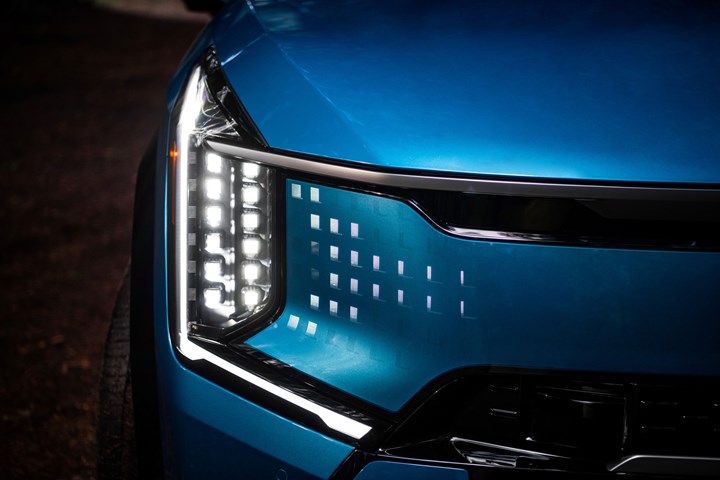
==
*Yes the Telsa Model Y (the picture after the next one below) has three rows.
///
A Tire for Mars

A concept tire for traveling on. . .Mars. (Image: Nexen)
In case you’re wondering what tires for a vehicle that will roll around on Mars may look like, the image above shows what students at the Busan Design Promotion Center's Korea Design Membership Plus (KDM+) and personnel from Nexen Tire think.
And adding some cred to the tread: The “Mearth” tire—which has the ability to change its width depending on the terrain and has protruding sidewalls to facilitate land cultivation—was named a finalist in the 2023 International Design Excellence Awards.
(In case you’re wondering: NASA plans to send people to the surface of the Moon in 2025 on the Artemis III mission. Then there will be more missions to establish a base on the Moon. Eventually the Moon will be the platform from which there will be a mission to Mars. All of which is to say: the tire won’t be needed anytime soon.)
///
Innovation Is Important. So Is Excitement
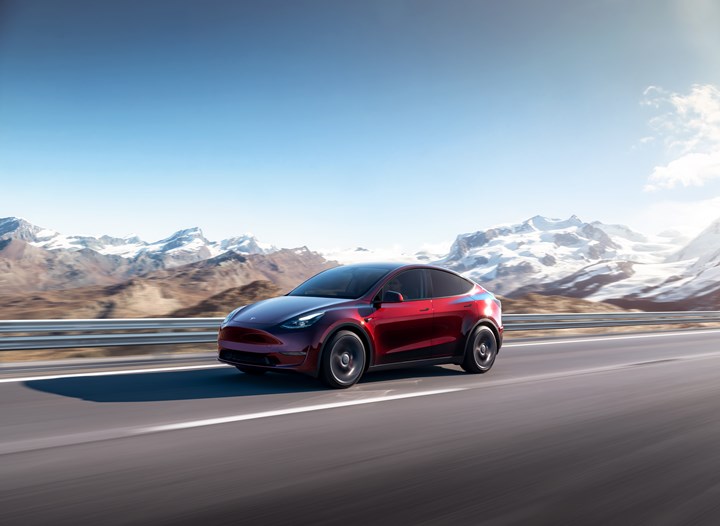
Yes, Tesla continues its dominance in the EV market. (Image: Tesla)
The Kelley Blue Book assessment of electric vehicle sales in the first half of 2023 have it that ~557,000 EVs were delivered in the U.S. Of that, Tesla accounted for approximately 337K.
While there was either glee or consternation related to the calculation that Tesla accounted for 59.3% of the market, down from 60.5% from the first six months of 2022, it is quite remarkable given that the list of manufacturers includes 35 other companies for the remaining 40.7% of sales.
So when people talk about “the EV market” keep in mind that by and large it is dominated by one brand in a way that is completely inconsistent with the norm of the auto industry as it has been known.
Looking at Innovation
The J.D. Power 2023 U.S. Tech Experience Index (TXI) study was released last week.
It looks at both expectations and experiences with advanced tech—40 things ranging from ADAS to gesture control.
While both EVs and ICEs are considered, Kathleen Rizk, senior director of user experience benchmarking and technology at J.D. Power, notes:
“Innovation through a strong advanced tech strategy is crucial for all vehicle manufacturers, especially those working to build their reputation in the electric vehicle space.
“The perception in the industry is that most BEVs should offer many advanced technologies to compete with high-tech entrants like Tesla. Success will be dependent on those manufacturers that can execute flawlessly, while ensuring the user experience is the same for those who are tech savvy and those who are not.”
Without Tesla
The good news for all of the EV brands that aren’t Tesla is that Tesla isn’t included because it doesn’t meet with study award criteria (as in availability of sales information to J.D. Power, for example).
Were it, then on the 1,000-point scale for Innovation in the Premium vehicle segment it would be at 773 points.
But it isn’t, so Genesis tops the ranking with a score of 656. Unlike Tesla, which is fully EV, three out of eight Genesis models are EVs (though the company is making a transition to EV power).
Know This
Here’s a big takeaway from the TXI study:
- “New manufacturers (e.g., Tesla, Rivian, Lucid and Polestar) are making a very strong debut in the U.S. market in terms of their advanced tech offerings. . . .[M]ost of the innovation of these newer brands far exceeds that of traditional manufacturers—except for Genesis. . . .”
Presumably these “new manufacturers” are, in effect, starting from the proverbial clean sheet and so find it simply normal to include the sorts of tech that they are familiar with from their day-to-day experiences.
Meanwhile, the traditional manufacturers are busy trying to not only develop and execute new propulsion systems but, at the same time, moving to more digital deployments.
Building Excitement
Which brings us back to Tesla.
Although the build quality of Teslas has been improving, odds are you’ve heard people talk about how there are some things they’ve experienced with those vehicles that probably wouldn’t be acceptable from the traditional OEMs.
But that matters little to them.
J.D. Power found that the average problem levels for advanced tech among the new manufacturers (except for Polestar which, it should be noted, doesn’t officially qualify for the TXI) are “well above the premium average” and “among the highest in the industry.”
But customers probably don’t care.
- Here’s something to consider:
Tesla continues to have a hold on the EV market because it was an innovator and captured the early adopters—and because it created what is arguably a fan base.
The other new manufacturers are working to create fans, too, as in Rivian for the outdoor community; Polestar for those who are keen on environmental awareness; Lucid for those who want exceptional performance and amenities.
Arguably the traditional manufacturers are not only need to up their tech quotient but create fans for their EV offerings, something that has not been in their marketing playbook for quite some time.
///
(Somewhat) Normalized
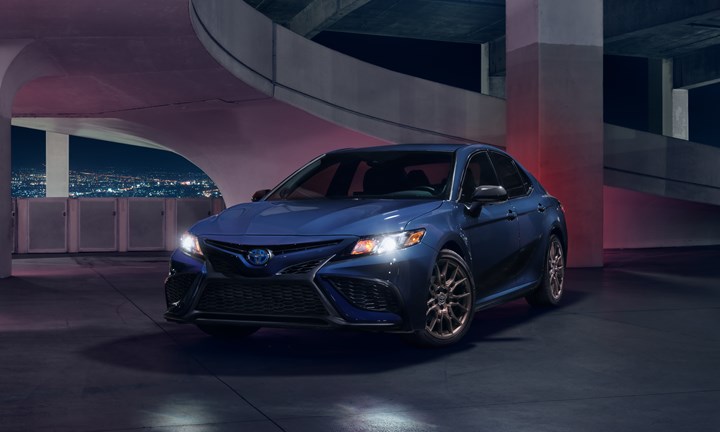
Not only do people buy a lot of Camrys, the like them, too. (Image: Toyota)
The American Customer Satisfaction Index (ACSI) Automobile Study 2022-2023 shows the automotive world isn’t entirely upside down as a result of Tesla.
The 8,941 customers interviewed came back with some “regular” results:
- Toyota is the most satisfying Mass-market nameplate. It garnered a score of 84, followed by Subaru at 82, Honda at 81, and Mazda at 80. Rounding out the top five are three brands from a traditional domestic: Buick, Chevrolet and GMC all received scores of 79 out of 100.
- Lexus (a “regular” marque) with 83 points, tops the Luxury nameplate list. . .though it is tied with Tesla.
Overall, customers are happier with their vehicles than they have been in the past. In 2022 the satisfaction was 77 out of 100. For 2023 ACSI has the number at 79, a 3% improvement.
As regards customer experience benchmarks—everything from driving performance to warranties—all of the categories were up year-over-year, with the exception of “Technology (controls, displays, audio, navigation, video systems)” in the Mass-market category, which is a tie with last year, and “Comfort (seating, ride, quietness)” in the Luxury category.
There was one that went down by a point (to 82 from 83): “Interior (look, space, cargo capacity, features, material quality)” in Luxury.
And Now a Warning
Although it didn’t provide numbers, Forrest Morgeson, Associate Professor of Marketing at Michigan State University and Director of Research Emeritus at the ACSI, had some words of caution for companies aggressively going electric.
Apparently, EVs rank last in dependability and customer expectations for reliability.
What’s more, EVs have the highest complaint rate.
Morgeson:
“EVs must improve before automakers can justify the price differential for a broader audience. Early EV adopters find these vehicles perform well relative to their expectations, yet ACSI data show they are only superior in technology and warranties. That is not enough to convince more consumers to leave gas in the past.”
(To go back to the previous entry above: Fans will give EVs a pass. Traditional vehicle purchasers will complain.)
///
Women Are Better Drivers
This is something that many (most?) males probably don’t want to know:
Women—especially those between ages 25-64—are better drivers. At least from the standpoint of their not being involved in nearly as many fatal accidents:
“According to FARS and the Federal Highway Administration, there were 3,181 driver deaths and 78,200,509 licensed drivers in 2020 that were females ages 25–64. Thus, there were approximately 41 deaths per million licensed female drivers ages 25–64. For all other driver classifications, there were 15,080 deaths and 149,995,293 licensed drivers, yielding a rate of 101 deaths per million licensed drivers.”
That from “Demographic adjustments to driver death rate by vehicle type and size,” a study by Charles M. Farmer for the Insurance Institute for Highway Safety (IIHS).
As for vehicle type:
“Sports cars were the vehicle type with the highest driver death rate, 91 per million registrations per year.”
And evidently women from 25-64 driving sports cars are more careful than men: of sports car fatalities, women accounted for 9%.
The death rate of 25-64 year old females driving pickups was 6%, according to the IIHS calculation.
In the nonluxury SUV category, females ages 25-64 accounted for 25% of fatalities.
Still, when you flip the figures it is fairly evident that men need to do a better job behind the wheel of whatever they are driving.
///“We’re Going to Need A Lot of Lithium. . .”
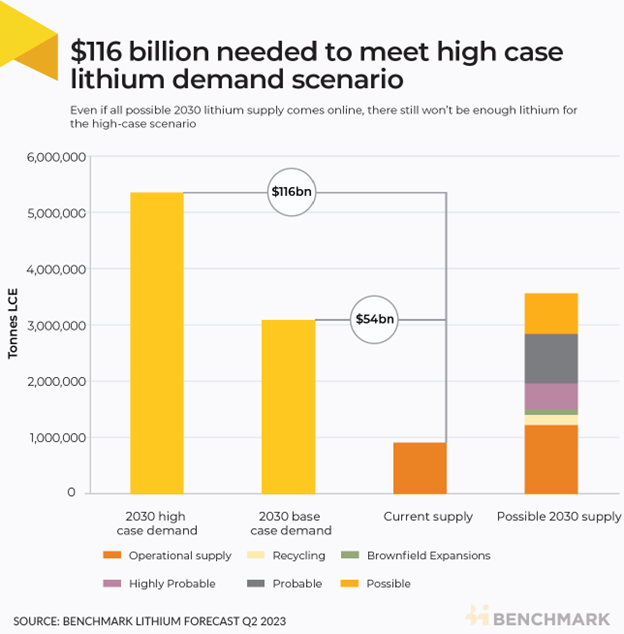
A lot of money is needed for a lot of lithium. (Image: Benchmark)
(Cue the Jaws theme)
Here’s a quote that plenty of product planners who are penciling the future of electric vehicles:
“It’s almost impossible, and definitely a race against time The big money that needs to be spent takes time to get approval for and to deploy.”
That’s Cameron Perks, an analyst at Benchmark Mineral Intelligence, a firm that specializes in forecasting materials and the supply chains for them. Materials including cobalt, nickel, natural and synthetic graphite, and lithium.
The “almost impossible” part?
$116-billion by 2030.
That’s the amount of investment that the lithium industry requires—for things ranging from mines to processing—if the global OEMs are going to hit their electrification targets, as well as meet government mandates.
The OEM and policy targets, Benchmark reckons, would mean that global EV sales would represent 82.5% of the market in 2030. That would mean that 5.3 million tonnes of lithium carbonate equivalent (LCE) are needed.
How much LCE is produced now?
915,000 tonnes.
Admittedly the $116-billion is the “high case scenario.” A more modest $54-billion is the “base case.”
Benchmark says that the high case would mean the capacity to produce 7.0 TWh worth of batteries. The base case scenario would be 3.9 TWh.
However, the firm estimates that the way things look at present, there will be the amount of lithium produced in 2030 that would result in 3.2 TWh.
How does this feel?
“As a carmaker, consumer, or EV policy maker, should I be alarmed?
“Yes,” Perks said.
///
2023 Range Rover Sport

Sometimes your commute may be a bit more challenging. This SUV, the Range Rover Sport, can take it. (Image: Land Rover)
The Range Rover Sport—frequently referred to as the “New Range Rover Sport,” as though “New” is part of the name (although who is going to go into a new car dealership and ask for the “Old Range Rover Sport”?)—was introduced last year.
It is still fresh. Given what is arguably a minimalist design, with purposeful elements and little in the way of extraneous bits, even if part of that purpose is aesthetic, it will probably still look fresh when the New New Range Rover Sport is introduced at some point in the future.
Robust
A most impressive aspect of the vehicle is its taut body. The sheet metal and the enhancing paint (i.e., the paint here seems to be fundamental to the form, not additive) make it appear as though the SUV is more of a rolling sculpture than a vehicle that you can take to places that are, well, downright silly for something that looks that good and might get scratched while traversing there.
A lot of that capability has to do with things like Dynamic Air Suspension (i.e., switchable volume air springs); “Stormer Handling Pack” (sounds like something out of the Marvel Cinematic Universe), which include Dynamic Response Pro, all-wheel steering, and an electronic active differential with torque vectoring by braking; and the Terrain Response system, which includes adaptive off-road cruise control (of course you’re going to put it in cruise while negotiating the Kárahnjúkar Spillway in Iceland).
Of course, the likelihood that anyone buying one of these sculptural, capable machines would dodge racing water or mount seemingly insurmountable rocks is approximately less than zero. But there is the confidence in knowing—and in being able to brag about—the capability of doing so.
The vehicle is based on the MLA-Flex architecture, shown below, which increases the vehicle’s torsional stiffness by 35% compared to the outgoing model. Said more simply, the vehicle is stout.
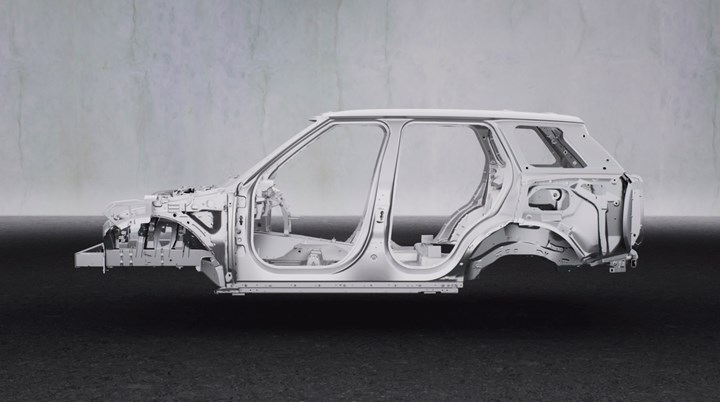
But nowadays, the tech quotient is of considerable interest. So the vehicle has 63 electronic modules capable of being updated via over-the-air (OTA) updates. There is a 13.1-inch centrally positioned touch screen running the company’s own Pivi Pro infotainment system. And there’s Amazon Alexa on board.
Land Rover is on its journey to electrification. This vehicle is offered with a 3.0-liter turbocharged six with a mild hybrid system. It is mated to an eight-speed automatic. Given that the vehicle tips the scales at some 5,300 pounds, it is somewhat surprising that according to the EPA it gets 19 mpg city, 26 highway and 22 mpg combined. Given the price of premium gas (yes, that’s what it takes), you’re going to want those sorts of results. Of course, if you’re acquiring a vehicle that starts at $83,000 maybe gas prices are irrelevant.
The thing about the Range Rover Sport has little to do with it robust structure or its powertrain or its infotainment system.
It’s that this is a vehicle that cossets you in comfort—and pedigree. Yet it is not something that is stale or stodgy.
What’s more—and undoubtedly better for some—is that you’re not going to see it in a country club parking lot along with so many copies that the lot seems like it belongs to a dealership.
There’s something to be said for exclusivity.
///
Safer Is Better
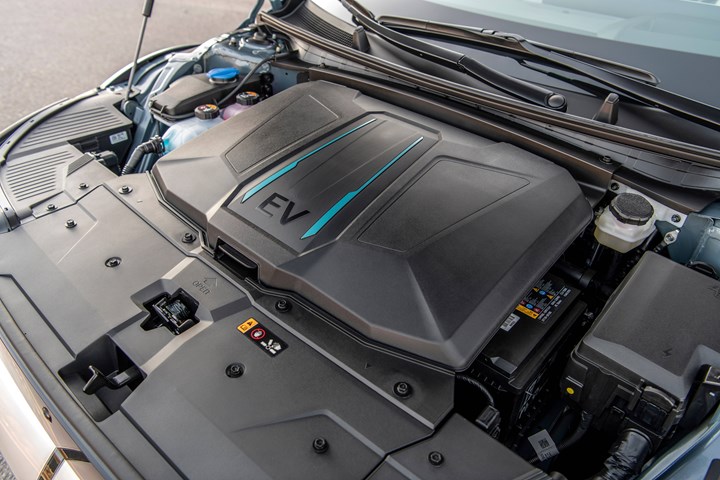
Under the hood of the Hyundai IONIQ 5. (Image: Hyundai)
One of the concerns about electric vehicles that isn’t range (doesn’t it seem strange that potential travel distance is a vehicle purchase consideration: did anyone ever ask a dealer how many miles a Camry or F-150 would go before refueling?) is an issue related to battery fires. Who hasn’t seen YouTube videos of EVs on fire that seem to resist the best efforts of fire personnel?
(According to a story in Firehouse last year, fire fighters in Stamford, CT, applied 600 gallons of water per minute for 40 minutes (2,400 gallons!) to put out a Tesla fire.)
We were wondering about how battery management is, well, managed by a leading builder of EVs, so we asked Brian Latouf, Global Chief Safety Officer, Hyundai Motor Corp. & Chief Safety Officer, Hyundai Motor North America (during the first half of 2023 Hyundai delivered 22,176 EVs, which puts it in the top four behind Tesla, Chevrolet and Ford).
The challenge?
Latouf:
“We believe it is important to educate consumers that EVs are every bit as safe as internal combustion engine vehicles. EVs do, however, provide a different set of engineering challenges, such as high-voltage battery systems and electrical pathways to power the motors, potential for electrical shorts, unique characteristics of lithium-ion battery cells and managing the cold and heat for optimum operating efficiency. However, although EV battery packs are combustible, they can be engineered to be just as safe as a gas tank and fuel system.
And that’s accomplished. . .?
Latouf:
“Hyundai has conducted a tremendous amount of ongoing research, development and has gathered years of field experience to improve EV batteries in general. Hyundai has engineered an advanced Battery Management System (BMS) to diagnostically monitor and manage battery conditions, both in an operating state and ignition off–parked state. Hyundai’s BMS will monitor cell voltage, cell resistance, module temperature changes at specific time intervals to determine if there are any issues with the battery system during operation, charging or a parked state. Hyundai also uses the crash sensors embedded in the vehicle to isolate the high-voltage current to be maintained in the battery pack post-crash. This approach minimizes the potential for electrical shorts or an electrical burn hazard to be present. Hyundai has also published emergency response guides for first responders on how to effectively manage an electric vehicle if a crash or issue occurs in field use. Safety is of paramount importance to Hyundai in designing, testing, and manufacturing electric vehicles.”
///
Euro Powertrain in July

The percentages of powertrain types sold in the European Union in July ‘23. The only thing that should make producers of internal combustion engines and components happy is that growing slice of hybrids because the straight petrol-alone share is shrinking. (Image: ACEA)
When some people, who have never been there, think about cars in, say, Germany, they probably imagine Mercedes S-Class and BMW 7 Series vehicles rolling along the Autobahn in abundance.
However, in Germany, as in other European countries, gasoline is more than moderately expensive.
Vehicles are typically smaller and more fuel efficient than you’ll find on I-75.
Cost of Fuel
According to GlobalPetrolPrices.com, between May and the end of August, the average price of a liter of petrol in Germany was €1.82.
- That translates to $7.52 per gallon.
Which goes a long way to explaining why vehicles with plugs are doing significantly well in the EU vs. the U.S.
The Market
Latest figures from the European Automobile Manufacturers’ Association (ACEA) show that in July, battery electric vehicle sales accounted for 13.6% of the EU vehicle market, up from 9.8% in July ’22.
(And to go back to that Germany reference: EV sales there were up 68.9%.)
Plug-in hybrids held their own, maintaining a market share of 7.9% in July.
Standard hybrids were up 31.6% in July, so they are 25.6% of the market.
Summing those numbers: 13.6 + 7.9 + 25.6 = 47.1.
The market for gasoline-only powered vehicles is at 35.8%, down from 39.3% last July.
$7.52 a gallon. . . .
<<<
RELATED CONTENT
-
TRW Multi-Axis Acceleration Sensors Developed
Admittedly, this appears to be nothing more than a plastic molded part with an inserted bolt-shaped metal component.
-
Plastics: The Tortoise and the Hare
Plastic may not be in the news as much as some automotive materials these days, but its gram-by-gram assimilation could accelerate dramatically.
-
On Electric Pickups, Flying Taxis, and Auto Industry Transformation
Ford goes for vertical integration, DENSO and Honeywell take to the skies, how suppliers feel about their customers, how vehicle customers feel about shopping, and insights from a software exec


.jpg;width=70;height=70;mode=crop)






